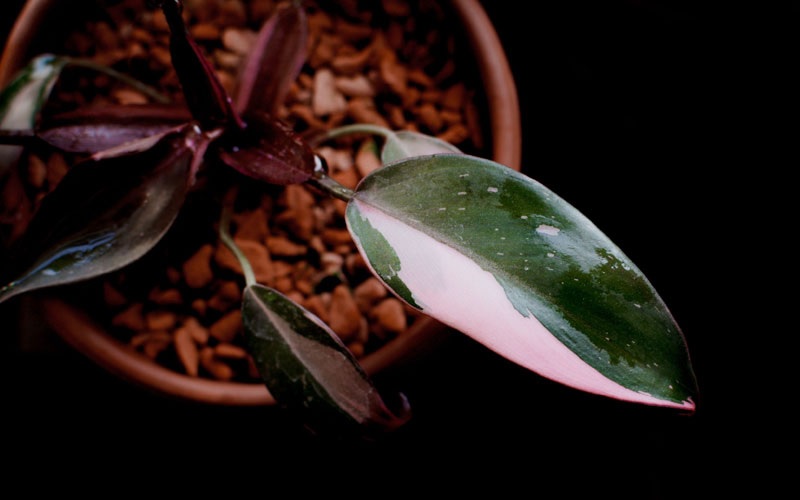Once a unicorn plant, now found in many garden centers – the pink princess philodendron plant’. Even if the price is on the decline, the Pink Princess is enjoying popularity like never before. You can find out how to care for the pink princess philodendron in this article.
The leaves are green and arrow-shaped and feature variety and splashes of pink and red tones.
Although this plant is called a “princess”, you are not dealing with a fussy plant. Like most other philodendron plants, this one is easy to grow.
Pink Princess Philodendron Origins
Nobody really knows where the pink princess philodendron comes from. It is assumed that this is a hybrid. Many assume that the Philodendron erubescens is involved. However, what this philodendron species was crossed with is a mystery.
It seems certain that this is not a naturally occurring plant, but that this plant was deliberately bred or “artificially” created.
Other names of Pink Princess Philodendron
With us, the Philodendron × ‘Pink Princess’ is often simply referred to as Pink Princess Philodendron or just Pink Princess . Abbreviations such as PPP ( Pink Princess Philodendron ) or PP ( Pink Princess ) have also become common .
In English it is also known as “ Red-leaf Philodendron ” or “ Blushing Philodendron ”.

Size of Pink Princess Philodendron
Outdoors, in its natural habitat, this plant can reach great heights. It is a vine that will climb and migrate under the right circumstances.
While indoor climates can be very close to those in its natural habitat, the plant does not typically grow taller than 90cm. In fact, most pink princess philodendron plants have an average height of around 60 cm.
One reason it is a desirable plant for apartments is that it has a slower growth pattern indoors and therefore requires little maintenance.
Be careful when buying plants!
There are many shady individuals out there trying to make a quick buck off the hype of these plants. There have been several instances where chemically colored plants have been sold as Pink Princess Philodendron.
How much light does my Pink Princess Philodendron need
Like most Philodendron species, the Pink Princess Philodendron loves indirect but very bright light. It can also cope with morning or evening sun, but direct sunlight should be avoided during the day.
Because the Pink Princess Philodendron would normally grow in the shade of the trees, its leaves are not adapted to direct sunlight and burn very quickly. This is especially true on variegated areas, as chlorophyll normally helps absorb light. These areas burn particularly quickly, turn brown and lose their color forever.
Of course, you can also grow your philodendron under a grow light. However, you should keep a minimum distance of 60cm here so that your plant does not burn.
Multiply Philodendron Pink Princess
scion cuttings
Proceed as follows to propagate your Philodendron Pink Princess using shoot cuttings:
- Find a healthy sprout (each sprout should have at least one node and optionally some leaves)
- Cut below the knot with a sterile tool
- Now you can pack your scion cutting either in water or directly in your philodendron soil
- You can also use root hormones as an additive
- Place your scion cutting in a warm place with plenty of indirect sunlight
- After a few weeks, you should see roots
moss
Another variant in which you create a clone of the plant and thus retain the characteristics is mossing. This type of propagation, which is apparently still relatively unknown to many, is often used in gardening to propagate trees.
With this method, you do the following:
wound your plant
- use a sterile blade
- the cut should be about 5cm long and 3-5cm deep
Keep the wound open
- the wound must remain open for roots to form
- to hold them open, you can use a toothpick
Moss the wound
- now you should cover the wound with moss
- the moss should be wet
- Sphagnum moss is best
- if the moss doesn’t stick to the wound, you can tie it up
- optionally, you can use rooting hormones to speed up the process
Wrap in foil
- Now take cling film and bandage the wound with it
- the foil should be strong enough to hold the moss in place
- you can also use tape to tie the foil in place
planting
- after a month the first roots can appear
- once the roots have reached 8cm, you can plant them
- detach the daughter plant from the mother plant
- now you can plant
How often should I water my Philodendron Pink Princess?
The issue of watering is extremely critical with this plant. Since the Philodendron Pink Princess is actually an epiphyte, it is not used to growing in the ground (more on that later). If the substrate gets too wet, root rot will develop quickly and a plant will die.
However, too little water should also be avoided, since it is a tropical plant after all. With too little water, the leaves will dry up and turn brown and you’ll lose the great coloring of these plants forever.
To prevent this from happening, you should pay close attention to when your Philodendron Pink Princess needs water and when it doesn’t. The best way to do this is to do a finger test.
With this you stick your finger or a wooden stick 2-5cm into the ground. If soil gets stuck, your Philodendron Pink Princess still has enough water, nothing gets stuck you should water.
When watering yourself, you should water more heavily than most plants. This is how you simulate the heavy rainfall in the rainforest. With this method, however, it is important that you pour away the water that is then in the pot.
Which substrate for Pink Princess Philodendron?
Since the Pink Princess Philodendron is very susceptible to root rot, as already explained, you should place this plant on an airy substrate that does not store too much water.
This will ensure that the roots of your philodendron always get enough oxygen and also prevent the formation of root rot.
The best option is to buy soil specifically for philodendrons or for aroids here. Alternatively, you can mix your substrate yourself from the following ingredients:
- sand or perlite
- potting soil
- moss
- mulch
- optional: compost
- optional: gardener’s charcoal
humidity
As a tropical plant, the Pink Princess Philodendron loves high humidity. In its natural habitat (or that of the plants it was grown from), the humidity is close to 100%.
Don’t worry, your goal shouldn’t be to mimic these conditions at all. This would lead to major problems, since the circulation in a closed room is much worse than that in a forest and fungi can form so quickly.
A humidity level of over 60% should nevertheless be aimed for. Humidity between 70 and 85% is optimal.
While the Philodendron Pink Princess can survive in humidities below 40%, it will grow very slowly here and will most likely lose its beautiful coloring.
What is the best way to achieve higher humidity?
To increase the humidity for your plants, you have several options.
Spray regularly
You can spray your Philodendron Pink Princess regularly with a conventional spray bottle to increase the humidity. However, this is only a temporary solution (so you will need to keep spraying your plant).
humidifier
For smaller rooms, a humidifier is the perfect solution. In larger rooms, on the other hand, the effect runs away, which is why the humidity is hardly increased here.
Plant tents or plant terrariums
tents or plant terrariums With plant tents or plant terrariums, you encapsulate your plant from the rest of the room, which means that you only have to increase the humidity in the terrarium or tent. In most cases, this is not only easier, but also more cost-effective.
group plants
When you group your plants, you create your own little jungle, which then also has the climate of a jungle (only in small, of course).
Special tip: Pebble Tray
Pebble trays are a popular DIY trick in the English urban jungle scene. Translated, Pebble Tray means pebble bowl and describes the method quite well.
This is how you can easily make your own Pebble Tray
- put some pebbles in a bowl
- fill the bowl with water
- Now you just put your plants on the tray
With this method, you can easily create a humid microclimate that your PhilodendronPink Princess will love!
Tip: group your plants in a large pebble tray for even better results.
Put plants in the bathroom
If no other tip worked, you can try putting your plant in the bathroom. The bathroom is the room with the highest humidity in most homes and is therefore a perfect place for the Pink Princess Philodendron.
What temperature for my Philodendron Pink Princess?
In the tropics there is not only high humidity, but also high temperature. Therefore, the philodendron loves temperatures between 23 and 30°C.
At night, the temperature should drop to 18-23°C so that the natural day-night rhythm is simulated.
The temperature should never fall below 14°C, as the Philodendron Pink Princess threatens to die here.
How often do I need to fertilize my Philodendron Pink Princess?
Although the philodendron grows relatively slowly, it still needs fertilizer. This fact can also be traced back to the natural habitat. Here the Philodendron Pink Princess has access to many nutrients.
A special philodendron fertilizer is best suited. Alternatively, you can also use a normal liquid fertilizer, but this should be diluted a little, otherwise it could damage the roots.
In winter you should fertilize less, since the plant grows less at this time and therefore uses fewer nutrients. Just give your regular ration every 8 weeks or spread it out over 8 weeks.
But isn’t more nutrients better?
This may sound logical at first and is also quite true in nature. However, this is not the case with the fertilizers that we use, since the nutrients are in salt form.
So when too much fertilizer accumulates in the soil, a lot of salt also accumulates, which now attacks the roots of our plant, causing the plant to die.
How often do I need to repot my Philodendron Pink Princess?
Like any plant, you will need to repot your Philodendron Pink Princess regularly. Due to the relatively slow growth, this plant does not have to be annual like most others. You’ll know to repot when roots grow out of the drainage holes.
Too much pink will kill your Pink Princess Philodendron
As already explained, variegated areas have less chlorophyll. However, it has not yet been explained that these areas also have fewer chloroplasts, the cell organelles in which photosynthesis takes place.
In summary, these areas produce little or no energy and must be supplied by the green part of the plant. Incidentally, this is also the reason why variegated plants grow a little more slowly.
For the most part, however, there are no problems other than a slower growth process, at least as long as the plant has a higher proportion of green than pink. A ratio of 50:50 is the absolute limit, as soon as there are more areas of pink than green, you should cut back particularly heavily colored leaves.
My Pink Princess Philodendron has no pink spots at all
With the Pink Princess Philodendron it can also happen that no pink spots are formed at all. However, you shouldn’t worry about this, especially with young plants, because variegation can also develop spontaneously.
To this day, botanists do not know what triggers variegation in these plants. What is certain, however, is that proper care promotes the development of pink spots. If the plant is completely green, it can also help to cut the plant back completely.
Why does my Pink Princess Philodendron have yellow leaves?
Aside from root rot, yellow leaves are the most common problem with philodendrons. Yellow leaves are due to watering problems 90% of the time.
Triggers can be either too much or too little water. To find out where the problem lies, you should look at the root ball of your plant. If you find root rot here, you have watered too much. On the other hand, if the root balls are dry, you should water your plant.
Is Pink Princess Philodendron Poisonous?
Like many other arum plants, the Pink Princess Philodendron contains calcium oxalate crystals and is therefore classified as poisonous.
So place your Pink Princess in such a way that children and pets cannot reach her.
Why is my Pink Princess Philodendron losing its variegation?
If the Pink Princess Philodendron does not get enough light, the proportion of variegation or variegation decreases. So make sure you have enough bright, indirect light.
Conclusion
The Pink Princess Philodendron or ppp plant is truly a “princess” of its kind. Its uniquely variegated leaves and apartment-friendly size make it a popular choice among plant lovers.
No special care is required compared to other philodendron varieties. Therefore, if you have already owned philodendrons, it will be easy for you to take care of this variety as well.
All of the precautions that apply to philodendrons also apply to this plant, including avoiding overwatering, frost, and direct sunlight.


